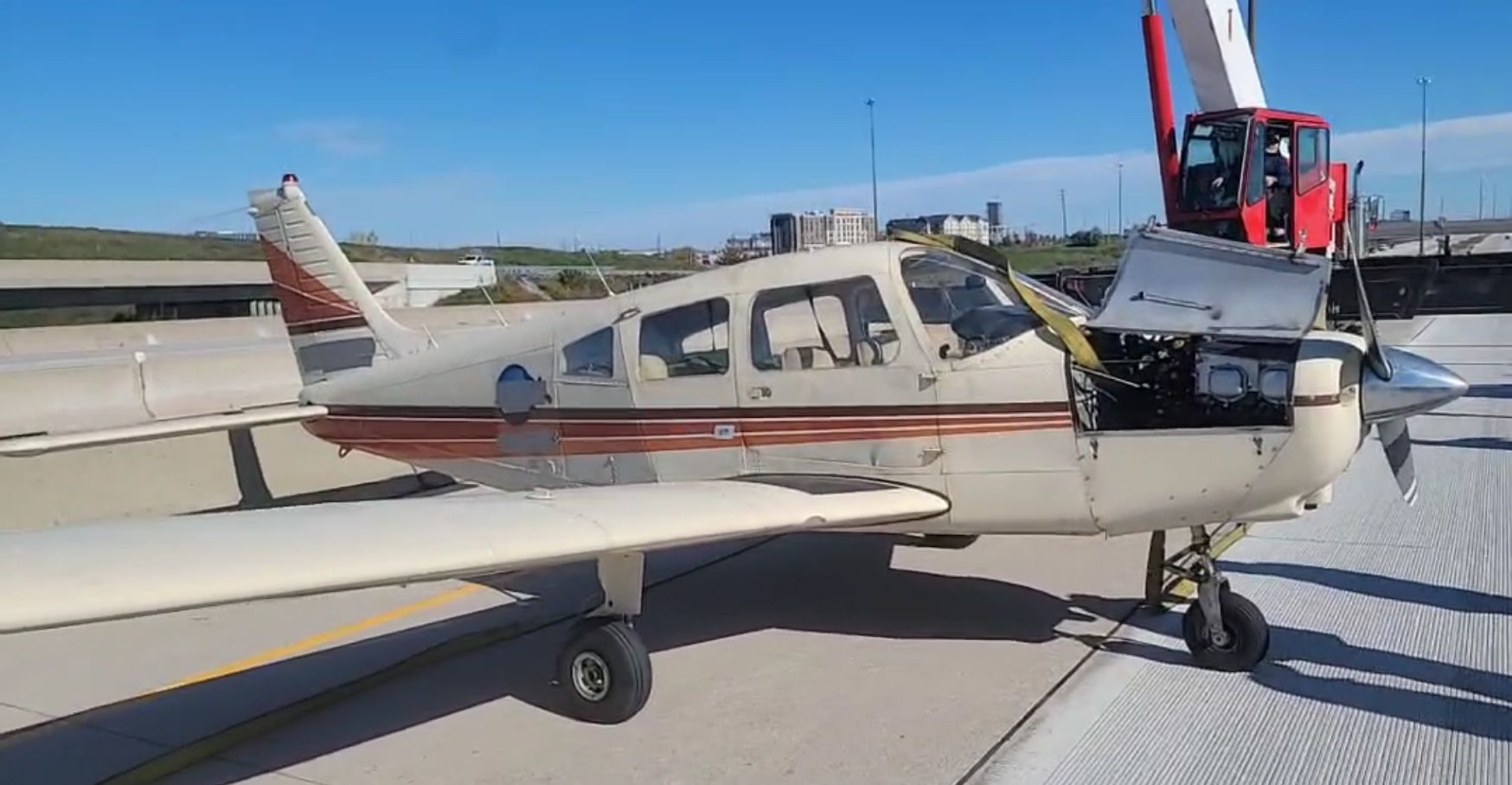A Piper Warrior made a successful emergency landing on Highway 407 outside of Toronto, Canada, after experiencing an engine failure shortly after takeoff on Wednesday. The two people onboard, both pilots, were not injured. According to the Ontario Provincial Police (OPP) Highway Safety Division, there was no damage to the aircraft or any vehicles on the ground.
The aircraft, which was on its first flight following a 100-hour inspection, departed from Buttonville Municipal Airport (CYKZ) at a little before 11 a.m. local time heading for Grimsby Regional Airport (CNZ8). The plane is registered to the Caribbean Flying Club, which is based at CNZ8. The pilot flying, an instructor at the club, reported that the runup was normal and the aircraft climbed to approximately 2,000 feet before the engine began sputtering following a fuel tank switch.
The aircraft was removed from the road via crane and flatbed truck several hours after landing. The cause of the incident is under investigation.
This article will be updated as more information becomes available.



































Good driving.
Sad looking little airplane.
The question is what happened. My pre-excitement policy is if I do anything (i.e. switch tanks) that causes excitement (stopped engine) first thing on agenda is to undo the change. In this case what happened when he went back to the prior tank; the one that the engine ran on?
Sounds like may have been fuel starvation.
CYKZ is at 650′ so since he was at 2,000′ he should have had maybe a minute or two to diagnose and act. I don’t know where the selector is in this plane but perhaps with two pilots one could drive the other can mess with the engine restart checklist. Mags, mixture, carb heat, tanks, etc.
Either way, well done, good landing.
Also I wonder if the 100 hour had anything to do with it. I’ve always been of the opinion annuals break airplanes.
Who in their right mind is changing fuel tanks so soon after takeoff, especially on an airplane’s first flight out of maintenance?
Indeed.
One of my pet peeves is pilots who switch fuel tanks immediately prior to takeoff or landing.
The wording of some checklists can be interpreted as encouraging this crazy practice.
All excellent comments below. Personally, my first flight after an annual is solo, good weather, orbiting over the airport while I check the major systems. If that goes well, I land and give the airplane a thorough post-flight inspection. If something isn’t right, my mechanics are in close proximity. I’m amazed that people load up their families and depart in low IFR after major work has been performed.
Hopefully, AvWeb will follow up on this.
I read on another site that both tanks flowed fuel when the plane was recovered. Even more odd….
First: Kudos to the pilot for a successful emergency landing made even sweeter because the airplane is reuseable.
Last night I checked out the NTSB’s aviation ‘statistics’ webpages. One of the most interesting was the 2018 ‘defining events’ for personal GA flying. “System Malfunction –Powerplant” was the second highest root cause of accidents and 3rd highest cause of fatalities. Add “Fuel Related” root causes (exhaustion or starvation) and loss of power, i.e. Powerplat + Fuel issues, and power loss was hands down the primary root cause of accidents and 2nd highest cause of fatalities. In that 60 second window we call ‘Takeoff’, the 2019 data showed 19 fatalities and about 75 accidents. It’s pretty obvious that the takeoff phase is the most risky part of every flight. Other data shows it’s also where we are most likely to experience power loss.
Double kudos to the Cherokee pilot.
Lessee – can position lights be modified to be brake lights?
:-o)
Let’s see, engine quits shortly after switching tanks, hmm. The POH, including checklists require the electric fuel pump on for T/O, landing and switching fuel tanks. It says that for a reason. Other likely possible cause is not positively positioning selector in detent for the tank. Other possibilities obviously exist, but these are starting points. As someone else pointed out, NTSB reports are numerous with “fuel mismanagement” as likely cause of accident. Changing fuel tanks are best done when you have lots of air beneath you.
Much that we don’t know in this factually brief report. Nice job of an off airport landing, eh, (eh, thrown in for the “hoseheads”).
Fuel selector on Cherokees is on the left wall under the panel, an easy reach while you’re flying the airplane. There was a problem with some older fuel selectors that made it possible to accidentally go to the OFF position instead of the other tank. The newer selectors have a positive lockout that requires substantial effort (both hands, almost) to shut the fuel off. All the old selectors should have been replaced via an AD some time ago.
Meanwhile, you have to wonder whether he tried switching back to the original tank. Still, there’s always the possibility of crud in the second tank that would gunk up the fuel system and render the first tank unusable as well. I try to make a point of being over an airport (or at least a landable surface) any time I switch tanks.